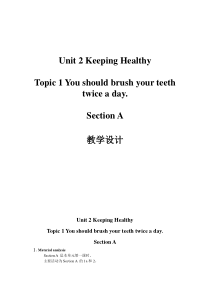 DOC
DOC
【文档说明】《Unit 2 Topic 1 You should brush your teeth twice a day》教案3-八年级上册英语仁爱(科普版).doc,共(8)页,68.500 KB,由小喜鸽上传
转载请保留链接:https://www.ichengzhen.cn/view-104933.html
以下为本文档部分文字说明:
Unit2KeepingHealthyTopic1Youshouldbrushyourteethtwiceaday.SectionA教学设计Unit2KeepingHealthyTopic1Youshouldbrushyourteethtwiceaday.SectionAⅠ.Materialan
alysisSectionA是本单元第一课时。主要活动为SectionA的1a和2。第二单元谈论如何保持健康。话题一介绍了感冒、头疼等常见病的名称,出现了疾病名称的词:toothache,backache,fever,cough,headache,stomachach
e等以及相对应的短语:haveacold,haveafever,haveacough,haveaheadache,haveatoothache,haveabackache,haveastomachache等。通过Kangkang和Betty的对话,呈现了询问生病情况的对话:What
’swrongwithyou?Ihavea…等,以及表达关心所提的建议:Youshould…和Youshouldn’t…。本课的语法重点是Youshould…和Youshouldn’t…。语言功能方面要求学生学会用英语描述疾病并能就疾病征求他人意见、给他人
提建议等。要求学生能在课后用英语写一篇描述疾病并提出有益健康的提建议的文章。Ⅱ.TeachingaimsKnowledgeaims:1.能正确运用以下短语进行书面表达:haveacold,haveafever,haveacough,haveaheadache,havea
toothache,haveabackache,haveastomachache等。2.能正确地运用should,shouldn’t提建议:Youshoulddrinkenoughboiledwater.Youshouldn’tdrinkcoffeeorteaint
heevening.Skillaims:1.能听懂有关日常小病的名称及相关话题。2.能熟练地运用should,shouldn’t针对日常小病提建议。3.能正确朗读介绍日常小病的对话或文章。4.能用should,shouldn’t结合本单元短语描述日常生活小病并提出有益的建议。Em
otionalaims:通过语言学习,影响学生的自身品格,要学会信任他人、关心他人,为我们的健康生活创建友爱、和谐的氛围。Ⅲ.ThekeypointsanddifficultpointsKeypoints:haveacold,ha
veafever,haveacough,haveaheadache,haveatoothache,haveabackache,haveastomachache等短语的理解及运用。Difficultpoints:就日常小
病用英语提建议。Ⅳ.Learningstrategies1.培养学生根据图片猜单词意思的能力。2.培养学生模仿已有例句造句的能力。Ⅴ.TeachingaidsComputermultimediaprojector,picturesofdifferentillne
ssesⅥ.TeachingproceduresStepInteractionpatternStudentactivityTeacheractivityIntroduction(7minutes)1.Thewholeclas
swork2.Thewholeclasswork3.Thewholeclasswork4.Somestudents’work5.Thewholeclasswork1.Focustheirattentionontheteacher.2.Listentoasongtogether.3.Stu
dentslistenandtrytounderstand.4.Volunteersanswer:(1)He/Shewantstobebeautiful;(2)Tobestrong;(3)Tobehealthy;5.Studentsfollowwhatthetea
chersays,andcomeintothenewtopicunconsciously.1.Greetstudentsreadyforlearning.2.Listenasongtogether.(ThisTimeforAfrica)Teachershowsit’st
hethemesongofthe2010WorldCupinSouthAfrica.3.Teacherasksaquestion“Doyoulikethissong?”It’saboutthefootballgame.4.Teacherasksaquestion“Doy
oulikesports?Whydoyoulikesports?”5.Theteacherleadstothenewtopic,“Yes,ifweexerciseeveryday,wewillbemorebeautiful,strongerandhealthier.
Ifyoudon’ttakepartinanysportsactivities,youwillbeilllikethechildrenhere.”Presentation(12minutes)1.Thewholeclasswork2.
Thewholeclasswork3.Thewholeclasswork4.Pairwork5.Thewholeclassworkandpairwork6.Groupwork7.Thewholeclasswork8.Thewholeclasswork1.Studentsreadthewordsac
cordingtothephoneticsymbolsandguessthemeaningsaccordingtothepictures.2.Studentsfinish1c.3.Studentstrytousetheverbphr
asestoaskandanswertogether.4.Studentsaskandanswerinpairs,using“haveacough”,“haveaheadache”,and“haveatoothache”.5.Studentsaska
ndanswerinpairs.6.Studentsdochainpracticeingroups’makingsureeveryonecansaythedialoguecorrectly.7.Studentsdochainpracticeint
heirgroupsasquicklyastheycan.8.Studentssaytheconclusionwiththeteacher.1.Teacherpresentssomepicturesaboutthenewwords:fever,cough,toothache,ba
ckache,headacheandstomachache.Guidestudentstolearnthewordswiththephoneticsymbols,showingtheverbphrasesun
derthepictures.2.Teacherplays1cforthestudents.3.Teacherasksandanswersabout“haveafever”asamodelforthestudentst
oimitate.A:What’sthematter?B:Hehasafever.4.Teacherintroduces“What’swrongwithhim/her?”tothestudentstodopairwork.5.Teacher
asksthestudentstopractice“What’swrongwithyou?Ihavea…”inpairsaccordingto1c.6.Teacherasksthestudentstoaskandansweraccordingt
o1cingroups.7.Teacherasksthesixgroupstodochainpractice,andthefirstthreegroupswillwinthegame.8.Teachermakesaconclus
ion,“Whenwetalkaboutillness,wemayuse—What’swrongwith…?—…have/hasa…”Consolidation(10minutes)1.Thewholeclasswork2.Thewholeclasswork3.Thewholeclasswork
4.Thewholeclasswork5.Thewholeclasswork6.Pairwork1.Studentslookthrough1bandmakesuretheyknowwhattodo.2.Studentslistenc
arefullyandfinish1b.3.Studentssaytheanswerstogetherandunderstandthemeaningof“suggestion”withthehelpoftheteacher’sexplanation.4.Studentsreadw
iththerecording,imitatingit.5.Studentsknowthemeaningsof1a.6.Studentsaskandanswerinpairs.1.Teacherleadsto1aforthestudentstofi
nish1b,saying“BettyandKangkangaretalkingaboutillness.Let’slistenandfinish1b.First,youshouldlookthrough1bandmakesure
youknowwhattodo.”2.Teacherplays1a,andthenchecksthestudents’answers.3.Teachercheckstheanswersandteachestheword“sugge
stion”bypointingoutitssynonym“advice”.4.Teacherplays1aforthestudentstoreadwithoutstopping.5.Teacherexplainsthekeyssentencesandpointsof1a.6.Teache
rasksthestudentstoaskandanswerinpairs.Practice(8minutes)1.Thewholeclasswork2.Thewholeclasswork3.Thewh
oleclasswork4.Thewholeclasswork5.Groupworkandpairwork6.Twostudents’work1.Studentslookatthepicturesandknowthemeaningsofthenewwords,andthenpronouncethe
newwordsaccordingtothepictures.2.Studentscatchthemeaningwhiledoingexercise2.3.Studentssaytheanswerstogetherafterdiscussio
n.4.Studentsmakeupnewconversationsandtheymaydiscussingroups.5.Studentspreparefortheperformanceinpairs,andtworepresentativeswillbe
chosenout.6.Thepairshoulddotheirbesttoperformwell.1.Teachershowspicturesofnewwordsonthescreen“coffee,tea,boil
edwater”withphoneticsymbols.2.Teacherexplainstheword“lift”bysayingitssynonym“carry”andasksthestudentstofinish2.3.Tea
cherchecksthestudents’answers.4.Teacherasksthestudentstomakeupnewconversationsaccordingto1cand2.5.Teacherasksthegroupswho
havelostthegameofpracticing1ctopracticetheirnewconversationsinpairs.Eachgroupfinishesonepair.6.Teacherasksthebestpairtoshowtheconversation
tothewholeclass.Production(8minutes)1.Thewholeclassworkandindividualwork2.Thewholeclasswork3.Thewholeclasswork4.Indivi
dualwork1.Eachstudentinterviewsonestudentandwritesdownthedialogue.2.Studentswritetheirinterviewsdownafterclass,preparingforth
ereportinthenextclass.3.StudentssummarizeSectionAwiththeteacherbydoingexercisesshownonthescreen.4.Studentsdothefollowingjobs:(1)Memorizethesummarya
fterclass.(2)Studentswritetheinterview“What’swrongwithyou?”afterclass,andthenprepareforthereportinthenextclass.(3)Studentslearntoreadvocabularywith
thehelpofrecordingandthephoneticsymbols,andreadthedialogaftertherecording.1.Teacherorganizesaninterviewaccordingto1cand2,andst
udentswilldoitintheirowngroups.2.Teacherasksthestudentstowritedowntheirinterviewsafterclass.3.Teachershowsthesummarytothestudents.(1)Vocabulary(2)t
hestructure:shoulddo4.Teacherassignshomework:(1)Reviewthesummaryafterclass.(2)Reporttheirinterviewstothewholeclasstomorrow.(3)PrepareSectionBafterc
lass.TeachingReflectionIt’salittlehardforthestudentstogivepropersuggestionsonillness.Theymaysearchmoreinformationaboutthistopicaftercla
ss.Ⅶ.BlackboarddesignUnit2KeepingHealthyTopic1Youshouldbrushyourteethtwiceaday.SectionAWhat’swrongwithyou?lookwellIhavea...shoulddosthHe
/Shehasa...shouldn’tdosth
 辽公网安备 21102102000191号
辽公网安备 21102102000191号
 营业执照
营业执照